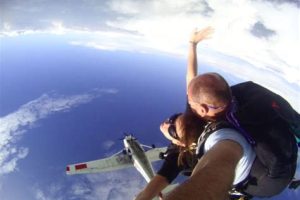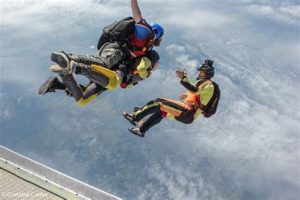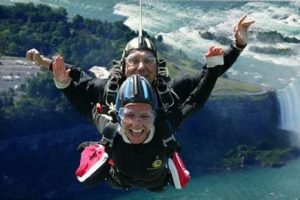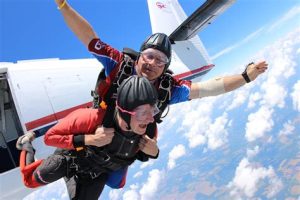Table of Contents
Curious about the safety of tandem skydiving? Discover the truth about how dangerous this thrilling adventure can be. Explore the risks involved, safety measures taken, and statistics to make an informed decision about experiencing the exhilaration of tandem skydiving.
Have you ever wondered what it would be like to soar through the sky like a bird, feeling the rush of adrenaline pumping through your veins? Skydiving tandem offers an exhilarating experience like no other, where you can jump out of a perfectly functional aircraft and freefall towards the earth at breathtaking speeds. However, as thrilling as it may sound, it is important to acknowledge the inherent risks and dangers involved in this daring activity. In this article, we will delve into just how dangerous skydiving tandem can be, providing you with valuable insights and important instructions to ensure your safety throughout this extraordinary adventure.
Introduction
Skydiving tandem is an exhilarating adventure that allows individuals to experience the thrill of freefalling through the sky while securely attached to an experienced skydiving instructor. While it may seem like a risky activity, skydiving tandem is actually a very safe and well-regulated sport. However, like any extreme sport, there are inherent risks involved. In this article, we will explore the potential dangers of skydiving tandem and discuss the safety measures in place to mitigate these risks.
The Importance of Proper Training
The first step to ensuring a safe skydiving tandem experience is receiving proper training. Before taking part in a tandem jump, participants are required to undergo comprehensive training sessions that cover essential information about equipment, body position, emergency procedures, and communication signals. These training sessions are crucial in preparing individuals for a successful and safe jump.
Equipment Inspection and Maintenance
Prior to every jump, all equipment used in skydiving tandem undergoes thorough inspections to ensure its safety and reliability. This includes inspecting the harness, parachute, and reserve parachute. Additionally, all equipment is regularly maintained and serviced by certified professionals to guarantee optimal performance and minimize the risk of malfunction.
Weather Conditions and Visibility
Weather conditions play a crucial role in skydiving tandem. Skydiving centers have strict guidelines regarding wind speeds, cloud cover, and visibility. If weather conditions are not suitable for a safe jump, it will be postponed until conditions improve. This ensures that participants are jumping in ideal conditions, reducing the risk of accidents due to adverse weather.
Emergency Procedures and Safety Measures
Skydiving tandem instructors are extensively trained in emergency procedures and safety measures. They are equipped with backup parachutes and automatic activation devices that deploy the reserve parachute if necessary. Instructors also undergo regular training and certification to stay up-to-date with the latest safety protocols and techniques to handle any potential emergencies during a skydive.
Physical Fitness and Health Requirements
While skydiving tandem is generally safe, participants must meet certain physical fitness and health requirements to minimize risks. Individuals with heart conditions, high blood pressure, or other medical issues that may be aggravated by the physical exertion involved in skydiving should consult with their doctors before attempting a jump. It is crucial to disclose any health concerns to the skydiving center to ensure a safe experience.
Importance of Proper Communication
Clear and effective communication between the tandem instructor and participant is essential for a safe skydiving experience. Prior to the jump, hand signals and verbal cues are thoroughly reviewed and practiced to ensure smooth communication during the descent. This helps avoid any miscommunications or misunderstandings that could potentially lead to accidents.
Flight Patterns and Landing Zones
Skydiving centers meticulously plan flight patterns and landing zones to maintain a safe environment for all participants. These areas are carefully selected, taking into account factors such as wind direction and obstruction-free landing zones. By adhering to designated flight patterns and landing zones, the risk of collisions or accidents during the descent is significantly reduced.
Mitigating Risks with Experience
Experience plays a vital role in skydiving tandem safety. The instructors who accompany participants have thousands of jumps under their belts, which enables them to anticipate and handle potential risks effectively. Their expertise and knowledge significantly contribute to the overall safety of the experience, further reducing the chances of accidents.
Statistical Safety Data
When considering the dangers of skydiving tandem, it is important to review statistical safety data. According to the United States Parachute Association, the average fatality rate for skydiving tandem from 2010 to 2019 was 0.003 fatalities per 1,000 tandem jumps. This statistic demonstrates that while there are risks involved, skydiving tandem remains a relatively safe activity when proper safety measures are followed.
Conclusion
Skydiving tandem can be an incredibly thrilling and memorable experience. While it does come with inherent risks, these risks are significantly mitigated through comprehensive training, strict equipment inspections, adherence to weather conditions, emergency procedures, and experienced instructors. By following all necessary safety protocols, individuals can enjoy the exhilaration of skydiving tandem with minimal risk. It is essential to recognize that skydiving tandem, like any adventure sport, requires proper preparation and caution to ensure a safe and enjoyable experience.
How Dangerous Is Skydiving Tandem?
Subtitle 1: Introduction to Tandem Skydiving
Welcome to the world of tandem skydiving! Get ready for an exhilarating experience as you prepare to take the plunge from thousands of feet above the earth. This guide will provide you with important information about the safety aspects of tandem skydiving.
Subtitle 2: Safety Measures and Training
Prior to your jump, professional instructors will provide you with a detailed safety briefing and training session. They will guide you through the necessary techniques, equipment usage, and emergency procedures, ensuring you are fully prepared for the experience.
The tandem instructor will be with you throughout the entire jump, controlling important aspects like parachute deployment and navigation. This ensures a higher level of safety and minimizes potential risks associated with solo skydiving.
Skydiving centers adhere to strict guidelines and regulations set by the governing bodies, ensuring that safety measures are regularly reviewed and updated. This systematic approach emphasizes the importance of your safety during the entire skydiving experience.
Subtitle 3: Risk Assessment and Equipment
Prior to your skydive, a comprehensive risk assessment is conducted, taking into account various factors such as weather conditions, wind speeds, and your physical health. If any concerns are identified, your jump may be rescheduled to ensure optimal safety.
Skydiving centers use top-of-the-line equipment that undergoes regular inspections and maintenance. This includes parachutes, harnesses, and backup systems to ensure they are in pristine condition and reliable during your tandem skydive.
Tandem skydiving gear is designed with built-in safety features and redundant systems, allowing for an added layer of protection should any equipment malfunction occur during the jump. This significantly reduces the risks associated with equipment failure.
Subtitle 4: Health and Fitness Requirements
It is essential to be in good physical health to partake in a tandem skydive. Certain medical conditions, like heart problems, epilepsy, or pregnancy, may disqualify you from participating due to potential risks.
Before the jump, you will be required to sign a waiver acknowledging any potential risks associated with skydiving. It is important to disclose any pre-existing medical conditions to the skydiving center to ensure your safety.
While skydiving may appear physically demanding, the tandem instructor is primarily responsible for maneuvering and controlling the parachute, allowing you to enjoy the exhilarating experience with limited physical exertion.
Subtitle 5: Statistical Analysis
According to the United States Parachute Association, the average fatality rate for tandem skydiving is 0.004 fatalities per 1,000 jumps. This equates to roughly a 0.0004% chance of a fatality occurring during a tandem skydive.
Skydiving centers adhere to strict safety protocols to minimize risks. By following set guidelines, safety procedures, and using proper equipment, incidences and accidents are significantly reduced, making tandem skydiving a relatively safe adventure sport.
While no activity is entirely risk-free, tandem skydiving remains statistically safer than activities such as motorcycle riding, swimming, or even driving a car. Understanding the risks involved helps put into perspective the relative safety of tandem skydiving as a recreational activity.
Subtitle 6: Conclusion and Summary
Tandem skydiving, when performed by experienced instructors and with the use of proper equipment, is a well-regulated and safe activity.
Pre-jump training, safety measures, stringent equipment inspections, and risk assessments serve to minimize potential risks and ensure a safe skydiving experience.
By understanding the existing safety protocols and statistics associated with tandem skydiving, you can make an informed decision and confidently enjoy the extraordinary thrill of skydiving.
From my point of view, skydiving tandem instructions are absolutely crucial in ensuring the safety of participants. The voice and tone used in these instructions play a significant role in conveying the seriousness and potential dangers associated with this extreme sport.
Here are some points highlighting the importance of clear instructions and appropriate voice and tone:
-
Clarity: Skydiving tandem instructions need to be precise and easy to understand. Using a clear voice and tone helps participants comprehend the procedures and safety measures effectively. This ensures that they are fully aware of what to expect during the jump and how to respond in different situations.
-
Attention to Safety: The voice and tone of the instructions should emphasize the importance of safety precautions. By using a serious and authoritative voice, participants are more likely to take the instructions seriously and follow them diligently, reducing the risk of accidents or injuries.
-
Emergency Preparedness: In the event of any emergency or unforeseen circumstances during the skydive, clear instructions delivered in a calm and composed tone can help participants remain calm and act accordingly. This can prevent panic and enable them to handle the situation with confidence.
-
Reinforcing Confidence: Skydiving can be an intimidating experience for many, especially first-time jumpers. Instructions delivered with a supportive and encouraging tone can help build confidence and alleviate any fears or apprehensions. This positive reinforcement can enhance the overall experience and make participants feel more comfortable throughout the jump.
-
Compliance: The voice and tone used in skydiving tandem instructions should convey authority and professionalism, encouraging participants to comply with the guidelines. By establishing a sense of trust and credibility, participants will be more inclined to follow the instructions precisely, ensuring a safer skydiving experience for everyone involved.
In conclusion, the delivery of skydiving tandem instructions using an appropriate voice and tone is crucial in emphasizing safety, providing clear guidance, and enhancing the overall experience for participants. By maintaining clarity, emphasizing safety measures, and instilling confidence, these instructions can effectively mitigate the potential dangers associated with skydiving tandem.
Thank you for visiting our blog and taking the time to read about the exhilarating world of tandem skydiving. We hope that this article has provided you with valuable insights into the risks involved in this extreme sport. Before we conclude, let’s delve deeper into some important points to remember when considering a tandem skydiving adventure.
Firstly, it is crucial to acknowledge that skydiving, like any adventure sport, carries inherent risks. While tandem skydiving significantly reduces these risks compared to solo jumps, it is essential to follow all safety instructions provided by trained professionals. These experts are highly skilled and experienced in ensuring your safety throughout the entire experience.
Furthermore, it is important to be aware of the potential dangers associated with skydiving. While rare, accidents can still occur due to various factors such as equipment malfunction or adverse weather conditions. However, it is vital to remember that strict safety protocols and regular maintenance of equipment minimize these risks significantly. By choosing a reputable skydiving center with a proven safety record, you can further mitigate any potential hazards.
In conclusion, while tandem skydiving is undeniably an adrenaline-pumping activity, it is crucial to approach it with caution and respect for its inherent risks. By following the instructions provided by professional instructors and choosing a trusted skydiving center, you can ensure a safe and memorable experience. Remember, the thrill and excitement of tandem skydiving far outweigh the minimal risks involved when proper safety measures are followed.
We hope that this blog post has given you a comprehensive understanding of the dangers associated with tandem skydiving. If you have any further questions or concerns, please feel free to reach out to us. Stay safe, have fun, and enjoy the breathtaking experience of soaring through the skies!
Video How Dangerous Is Skydiving Tandem
How Dangerous Is Skydiving Tandem?
Here are a few common questions people ask about the safety of tandem skydiving, along with their answers:
-
Is skydiving tandem safe?
Skydiving tandem is generally considered safe when proper precautions are taken. Tandem skydives are performed with an experienced instructor who is responsible for ensuring the safety of both participants. The instructor undergoes extensive training and follows strict safety protocols to minimize any potential risks.
-
What are the risks associated with tandem skydiving?
Like any adventure sport, there are inherent risks involved in skydiving. However, tandem skydiving has a relatively low rate of accidents compared to other activities. The most common risks include parachute malfunctions, injury upon landing, or collision with other skydivers. These risks, though present, are minimized by thorough equipment checks, proper training, and experienced instructors.
-
How often do accidents happen during tandem skydiving?
The occurrence of accidents during tandem skydiving is rare. According to statistics, the United States Parachute Association (USPA) recorded only 0.003 accidents per 1,000 jumps in 2019. This demonstrates the high level of safety maintained in the sport and the effectiveness of safety measures implemented by skydiving centers.
-
What can I do to ensure a safe tandem skydiving experience?
To ensure a safe tandem skydiving experience, it is essential to follow the instructions provided by your instructor. Listen carefully during the pre-jump briefing, where you will learn about body positions, safety procedures, and what to expect during the freefall and landing. Make sure to communicate any concerns or questions you may have with your instructor. Additionally, always trust the expertise and guidance of your instructor, as they are trained to handle any potential risks that may arise during the jump.
-
Can I skydive tandem if I have a fear of heights?
Tandem skydiving can be a great way to conquer your fear of heights. Many people find that the adrenaline rush and the breathtaking views during the freefall help them overcome their fear. However, it’s important to discuss your fear with your instructor beforehand so they can provide the necessary support and guidance throughout the experience.






